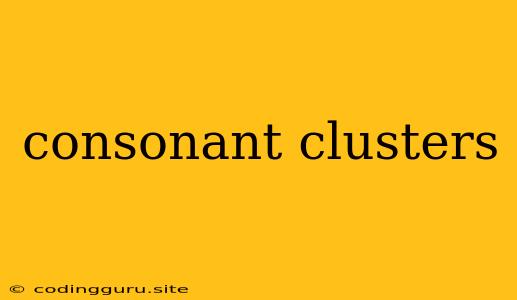What are Consonant Clusters?
Consonant clusters, also known as consonant blends, are groups of two or more consonants that appear together in a word, often at the beginning or end of a word. These clusters can be tricky to pronounce, especially for young learners or those learning a new language.
How Do Consonant Clusters Work?
Imagine a group of friends standing together. Each friend represents a consonant sound. When the friends stand close together, they create a cluster. For example, in the word "stop," the consonant sounds s and t stand together, forming a consonant cluster.
Where Do Consonant Clusters Appear?
Consonant clusters can appear at different positions within a word:
Beginning of a Word:
- "brown"
- "blue"
- "flower"
- "stone"
End of a Word:
- "sky"**
- "wind"
- "first"
- "help"
Middle of a Word:
- "handsome"**
- "mattress"**
- "linter"**
Why are Consonant Clusters Important?
Learning about consonant clusters helps us improve our:
- Pronunciation: Consonant clusters can make words sound more complex.
- Reading: Recognizing consonant clusters helps us decode words faster.
- Spelling: Understanding how consonant clusters work can help us spell words correctly.
Tips for Learning Consonant Clusters
Here are some tips to help you master consonant clusters:
- Practice, Practice, Practice: The more you practice, the easier it will be to pronounce and recognize consonant clusters.
- Break Down the Sounds: Break down the cluster into individual sounds. Say the sounds one by one, then blend them together.
- Use Visual Aids: Use pictures or flashcards to associate the cluster with the corresponding word.
- Play Games: Make learning fun by playing games that involve consonant clusters.
Examples of Consonant Clusters
Here are some examples of common consonant clusters in the English language:
Beginning of a Word:
- br: brown, bread, bright
- bl: blue, black, block
- fl: flower, fly, float
- fr: friend, frog, fruit
- gl: glad, glass, glove
- gr: green, grow, great
- pl: play, plant, please
- pr: price, pray, print
- sc: school, scream, scratch
- sk: skate, sky, skirt
- sl: sleep, slide, slow
- sm: small, smile, smoke
- sn: snow, snake, snap
- sp: spider, spoon, sport
- st: star, stop, stick
- sw: swim, swing, sweet
- tw: twin, twelve, twice
- wh: what, when, where
End of a Word:
- nd: hand, bend, land
- ft: lift, soft, craft
- mp: jump, lamp, camp
- nt: paint, want, plant
- st: best, rest, test
- sk: ask, desk, risk
Middle of a Word:
- nd: understand, handsome
- nt: gentleman, painting
- mp: jumped, camped
- nk: thankful, thinking
Challenges with Consonant Clusters
While consonant clusters are common in the English language, they can present challenges for learners. Some of these challenges include:
- Difficult Pronunciation: Some consonant clusters can be difficult to pronounce, especially for those whose native language does not have similar sounds.
- Confusion with Other Sounds: Some consonant clusters can sound similar to other sounds, leading to confusion. For example, "bl" and "br" can be difficult to distinguish.
- Reading Fluency: Consonant clusters can slow down reading fluency if they are not recognized quickly.
Overcoming Challenges
- Practice Pronunciation: Practice saying the clusters out loud and pay attention to the placement of your tongue and lips.
- Focus on Visual Recognition: Use flashcards or other visual aids to help you remember the clusters.
- Use Context Clues: Use the surrounding words and the meaning of the sentence to help you decode words with consonant clusters.
Conclusion
Consonant clusters are a common feature of the English language and play an important role in pronunciation, reading, and spelling. Learning about consonant clusters can improve your language skills and help you become a more proficient reader and writer. By practicing regularly and using the tips mentioned above, you can overcome any challenges associated with consonant clusters and enjoy the benefits of understanding these important linguistic elements.
